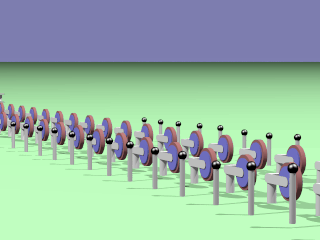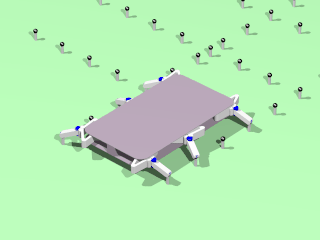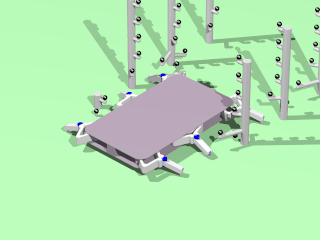Conveyors can be vehicles or extended arrays of rollers.
Pallets are flat platforms with legs that can be deployed and used to move the pallet for very short distances at about walking speed. They would be controlled by an autonomous unit built into the pallet and would be used to move it between rollers and vehicle, from one array of rollers to another or from a conveyor to a station for parking or loading and unloading.
Pallets would have a standard width but with varied units of length and pairs of legs with a minimum of three pairs. They would have a cabin or container which could be detachable or as a permanent structure.
Rollers would be in the form of a series of pairs of wheels with smart suspensions and drives and sensors that register the position, weight and specification of pallets as they are passed along the array.
A central controller would control the height, speed and headway of all the individual pallets, meaning that high traffic volumes can be handled.
Roller arrays can have differing specifications of speed, loading gauge and load capacity and only pallets with suitable specifications would be allowed to enter any particular array. So, for example, only long pallets with good aerodynamics would be carried on high speed arrays and only short pallets would be carried on arrays with sharp bends.
The spacing of rollers in arrays would be close enough so that individual rollers can be taken out of action and serviced when they fail.
The wheels would have troughs (up-side-down wheel arches) designed to catch the micro-particles shed by the tyres and shield the public from spray and noise.
The system should be reasonably weatherproof. Rain will not affect the underside of the pallet and will be spun off the wheels, which would tend to get hot anyway. Lifting of the pallets in high wind is restrained by a design feature that I have not introduced.
The legs would have feet that engage with footholds designed to constrain the foot in directions except upwards and revolution about a vertical axis. Footholds could also make electrical contact with the foot to supply power to the legs.
Here are some illustrations of some aspects of how the legs might work:




